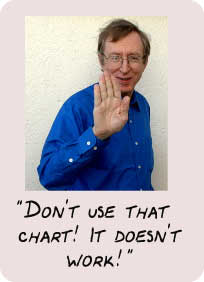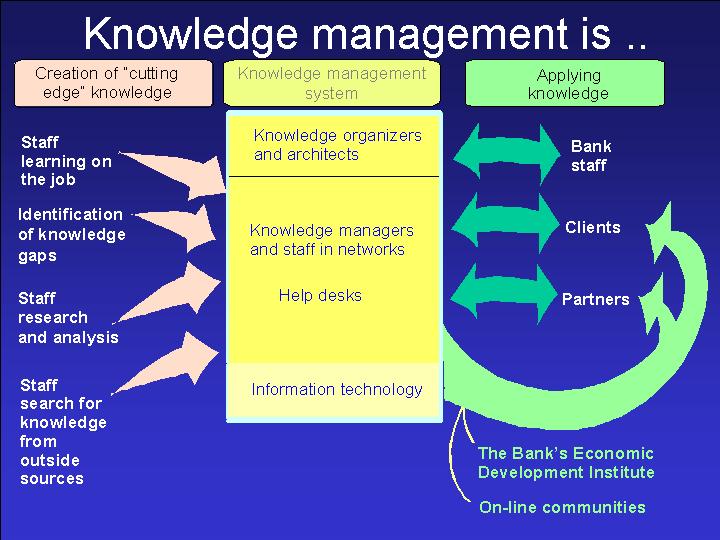|
|
Katalina Groh, Larry Prusak: Some of the world's leading thinkers |
| Storytelling to ignite change: Steve Denning |
 |
What
storytelling is explaining
And what is it that is being explained by the story? As we all know by now, knowledge management is a complex idea. I don’t know whether it has ten dimensions, or twenty dimensions, but it’s certainly got lots of dimensions that need to be mastered if it is going to implemented successfully. Let’s say for the sake of argument that knowledge management has sixteen dimensions. Our reaction to abstract explanations Well, if I say to you, “Let me explain to you in detail and depth right now each and every one of the sixteen dimensions of knowledge management,” you’re already |
| looking at your watch and thinking, “How do I get out of this meeting without causing an international incident?” You are not looking forward to a comprehensive explanation of knowledge management’s sixteen dimensions. |
 |
Our reaction to charts
If I say to you, “Let me show you a chart.” Now this is a chart that we actually used in the World Bank in 1997. And the senior management of our organization loved this chart. They thought that this chart was wonderful because you could see on the left hand side, there’s the the knowledge being created. And then you could see the knowledge passing through the yellow |
| boxes in the middle. And finally you could
see knowledge moving out through the green tongues on the right hand side
of the chart. Wow! They thought this chart is magnificent. That is it!
But I gradually figured out that the reaction of the staff in the organization was quite different. They couldn’t see how they related to these yellow boxes and green tongues. And so eventually, we dropped the chart because it just wasn’t having that kind of effect. Unfortunately friends and admirers of what the World Bank was doing in knowledge management had distributed this chart to organizations around the world. And so I still have people coming to see me and saying, “Steve, we’ve decided to use your chart, but I just need to understand what that long green tongue on the right-hand side is.” And I say to these people, “Please don’t use the chart. The chart doesn’t work.” “No, Steve,” they say, “I’m afraid you don’t understand. We’ve already decided to in my organization. We just need to know the meaning of the long green tongue on the right.” There’s nothing I can do except warn them that the chart doesn’t work. If I ask myself, why isn’t the chart working? Surely a picture is worth a thousand words, then we need to think a little about what a picture can and cannot do. Is it even theoretically possible that a chart could convey a complicated idea like knowledge management with perhaps sixteen dimensions. The problem is that depicting a sixteen-dimensional idea is very difficult, if not impossible to do in a drawing. Two, or three, or four dimensions, you can handle with a drawing, but with sixteen dimensions, you really need to be a professional mathematician to be able to visualize it. Our reaction to a story But if I say, “Let me tell you something that happened in Pakistan,” that is to say, a story, you’re immediate reaction is, “Yes, I’d like to hear about it.” You’re not sure what I’m going to pop out at you, but you’ve heard so many interesting stories, in your life, you have a positive attitude and expectation to the prospect of hearing a new story. And I may lose your interest by telling an boring story, or by telling an interesting story poorly, but my initial attitude and expectation towards the story is positive. Unlike the abstract explanation or the chart, I start out on a positive note. The explanatory power of stories But you might ask, “How could
this possibly work? How could a 29 word story like the Zambia story that
I just told you, how could that 29 word story possibly convey to you a
16 dimensional concept like knowledge management? That’s one-and-a-half
dimensions per word. Surely that’s not possible?”
|
| Books and videos on storytelling *** In Good Company : How Social Capital Makes Organizations Work by Don Cohen, Laurence Prusak (February 2001) Harvard Business School Press *** The Social Life of Information, by John Seely Brown, Paul Duguid (February 2000) Harvard Business School Press *** The Springboard : How Storytelling Ignites Action in Knowledge-Era Organizations by Stephen Denning (October 2000) Butterworth-Heinemann *** The Art of Possibility, a video with Ben and Ros Zander : Groh Publications (February 2001) |
| The views expressed on this website are those of Stephen Denning, and not necessarily those of any person or organization |
| Site optimized in 800x600: webmaster CR WEB CONSULTING |
|
|
|
|